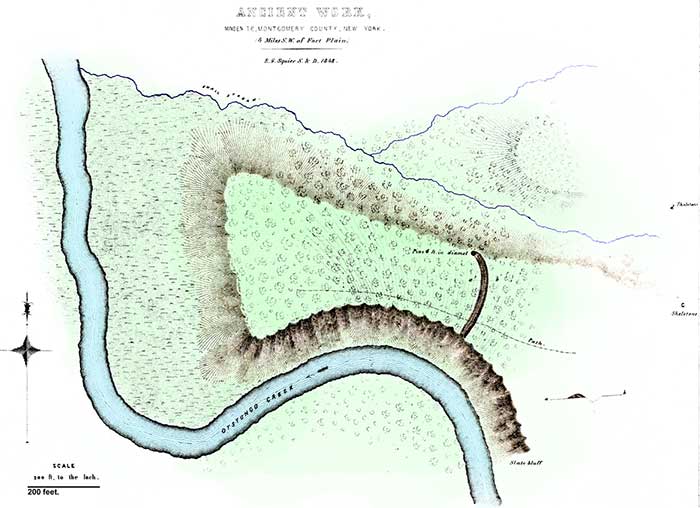MONTGOMERY COUNTY.

PLATE XII.
ANCIENT WORK, MINDEN TOWNSHIP.
It occurs upon the banks of the Otstungo Creek, a branch of the Otsquago,—itself a tributary of the Mohawk, about four miles in a southwestern direction from Fort Plain, in the town of Minden. It is known in the vicinity by the name of "Indian Hill." The position is admirably chosen, and is naturally by far the strongest and most defensible of any which fell under the observation of the author in the entire course of his explorations in this State. It is a high point of land projecting into a bend of the creek, which upon one side has cut away the slate rock, so that it presents a mural front upwards of one hundred feet in height, and entirely inaccessible. Upon the opposite side is a ravine, within which flows a small stream. Here the slope, though not precipitous, is very abrupt; and if a line of palisades were carried along its brow, it would be entirely inaccessible to a savage assailant. Across the narrow isthmus which connects this head-land with the adjacent high grounds, is an embankment and ditch two hundred and forty feet in length, extending from the precipice upon the south to the brow of the ravine on the north, along which, curving inwards, it is carried for some distance, terminating at a gigantic pine six feet in diameter. It has been supposed by some that this tree has grown upon the embankment since it was erected; but it seems most likely that it was the starting point of the ancient builders. The wall is not of uniform height, but at the most elevated point rises perhaps six feet above the bottom of the ditch. No gateway is apparent, but one may have existed where the "wood road" now crosses the entrenched line. The plan will afford an accurate idea of the position and its natural strength. The enclosed area is about seven hundred feet long by four hundred and fifty broad at its widest part, and contains very nearly six acres. It is densely covered with immense pines throwing over it a deep gloom, and, with the murmur of the stream at the foot of the precipice, impressing the solitary visitor with feelings of awe, which the professed antiquary might deem it a weakness to acknowledge.
Fragments of pottery and a variety of rude implements, as also copper kettles and other articles of European origin, have been found upon excavation within the enclosure and in its immediate vicinity. At c and d, skeletons have been disclosed by the plough. They were well preserved, and had been buried according to the Indian custom in a sitting posture.
The valley of the Mohawk in this vicinity, it is well known, was the favorite seat of the tribe whose name it bears, and has been made classical ground by the stirring incidents of our early history. It was here the Indians maintained themselves until the period of the Revolution, and it seems probable that it was they who erected the work in question at an earlier or later date in their history.11 It corresponds in position and character with the works of the other parts of the State, and is precisely such a structure as we might expect to find erected by a very rude people. It could not be ascertained that there are any traditions connected with it; in fact, its existence is scarcely known beyond its immediate vicinity. The first intimation concerning it was derived from O. Morris, Esq., of the New York Institution for the Deaf and Dumb, to whom the author would convey his acknowledgments.
11. In the London Documents preserved in the Office of the Secretary of State is a paper containing the observations of Wentworth Greenhalgh, who in 167 7 made a journey from Albany among the Indians to the westward. The following notices of the towns of the Maquaes, or Mohawks, are interesting in this connection :
- "The Maquaes have four towns, viz.: Cahainaga, Canagora, Canajorha, Tionondogue, besides one small village about 110 miles from Albany.
- "Cahainaga is double stockaded round; has four ports, about four foot wide apiece; conteyns about twenty-four houses; and is situate upon the edge of a hill, about a bow-shot from the river side.
- "Canagora is only singly stockaded, has four ports like the other, contains about sixteen houses, and is situated upon a flat about a stone's throw from the water's edge.
- "Canajorha is also singly stockaded, with like number of houses, and a similar situation, only about two miles distant from the water.
- "Tionondogue is doubly stockaded round, has four ports, four foot wide apiece, contains about thirty houses, and is situated on a hill about a bow-shot from the river."—Documentary History of New York, Vol. I., p. 11.

